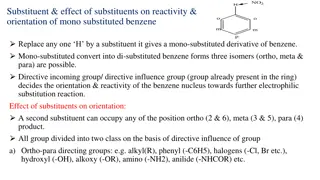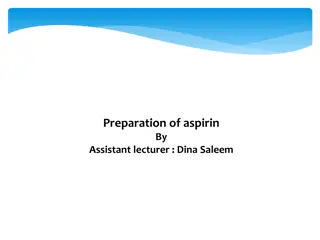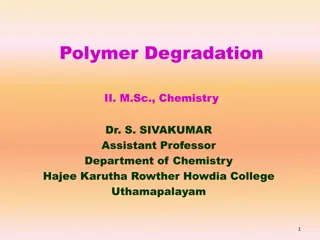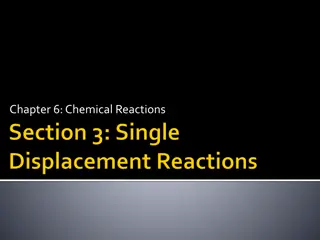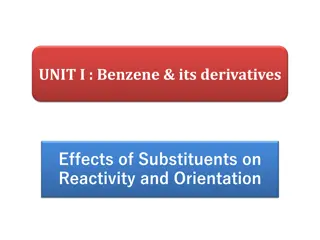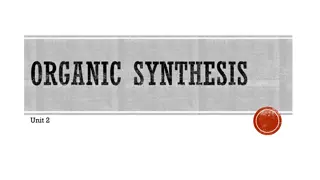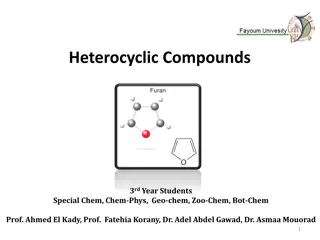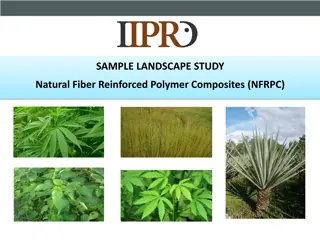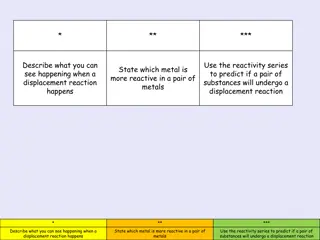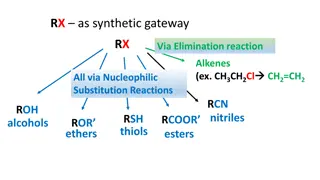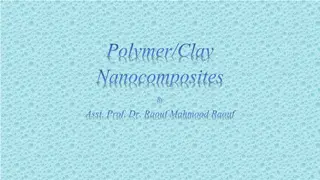Polymer Reactivity and Modification: Synthesis and Reactions
Reactions of polymers involve the synthesis of new polymers through modification, such as esterification of cellulose, crosslinking of polyisoprene, hydrolysis of poly(vinyl acetate), and chlorination of polyethylene. Polymer reactions utilize chemical processes to create new materials, carriers, or catalysts, impacting reactivity, functional group isolation, concentration effects, crystallinity, and solubility changes in the polymers.
Download Presentation

Please find below an Image/Link to download the presentation.
The content on the website is provided AS IS for your information and personal use only. It may not be sold, licensed, or shared on other websites without obtaining consent from the author. Download presentation by click this link. If you encounter any issues during the download, it is possible that the publisher has removed the file from their server.
E N D
Presentation Transcript
CHAPTER 9 REACTIONS OF POLYMERS the synthesis of new polymers by modification of existing polymers using a variety of chemical reactions 1) the esterification of cellulose, crosslinking of polyisoprene, hydrolysis of poly(vinyl acetate), and chlorination of polyethylene. 2) polymer reactions using a polymer as a carrier or support for some component of a reaction system (polymeric brominating and Wittig reagents, the Merrifield solid-phase synthesis of polypeptides, and polymeric catalysts)
9-1 PRINCIPLES OF POLYMER REACTIVITY Polymer reaction rates and conversions are usually lower than those for the corresponding low-molecular-weight homolog although higher rates are also found in some reactions 9-1a Yield 80% yield in the hydrolysis of methyl propanoate pure propanoic acid is obtained in 80% 80% yield in the hydrolysis of poly(methyl acrylate) not 80% yield of poly(acrylic acid) with 20% unreacted poly(methyl acrylate) but copolymer products with on the average 80% acrylic acid and 20% methyl acrylate units
9-1b Isolation of Functional Groups In the the random reaction of a pair of neighboring functional groups, the maximum conversion is limited due to the isolation of single functional groups between pairs of reacted functional groups. Ex) acetal formation in poly(vinyl alcohol) by reaction with an aldehyde. EX) the dechlorination of poly(vinyl chloride) maximum conversion : 83%
9-1c Concentration 1% solution of poly(vinyl acetate) molecular weight 106 Larger than 0.11 M of acetate groups; larger reaction rate 0 M of acetate groups : zero reaction rate The overall concentration of acetate groups is about 0.11 M The observed overall reaction rate: an average of the rates inside and outside the polymer coils The overall rate may be the same, higher, or lower than the corresponding reaction with a low-molecular-weight homolog of the polymer depending on the concentration of the small molecule reactant inside the polymer coils relative to its concentration outside.
9-1d Crystallinity Reactions of the polymers having crystalline regions heterogeneous product because only functional groups in the amorphous regions are available for reaction Ex) chlorination of polyethylene, acetylation of cellulose, and aminolysis of poly(ethylene terephthalate) 9-1e Changes in Solubility
9-1f Crosslinking For the crosslinked polymers, the concentration of small molecule reactant inside the polymer domains can be lower than outside because of a low degree of swelling.
9-1g Steric Effects Polymer reactivity can be sterically hindered, 1. functional group is close to the polymer chain 2. functional group is in a sterically hindered environment 3. Bulky small molecule reactants are used examples 1. hydrolysis of acrylamide copolymers with monomer I The rate decreases sharply with decreasing value of n, although the reaction rate is not affected by the molecular weight of the copolymer
2. Hydrogenation of cyclododecene using the polymeric rhodium catalyst II occurs at a rate 5 times slower than does cyclohexene The low-molecular-weight homolog III shows no difference in catalytic activity toward the two cycloalkenes. 3. n-C4H9I and n-C18H37I react at the same rate with pyridine, but n-C4H9I is almost fourfold more reactive than n-C18H37I toward poly(4-vinylpyridine)
9-1h Electrostatic Effects The conversion of uncharged functional groups to charged groups can decrease in reactivity with conversion. repells hydroxide ion Acceleration of reactivity is also observed
9-1i Neighboring-Group Effects the saponification of poly(methyl methacrylate) proceeds with autoacceleration when carried out with bases 9-1j Hydrophobic Interactions the hydrolysis of various 3-nitro-4-acyloxybenzoic acid substrates (V) catalyzed by imidazole (VI) and poly[4(5)-vinylimidazole] (VII) in ethanol water mixtures Catalysis by VII is more effective than by VII VII for n = 11 is 30-fold larger than for n = 1, and almost 400-fold larger than for VI.
9-1k Other Considerations 1. Reaction between functional groups on different polymer molecules occurs - when the two polymers are sufficiently similar (polymer chain interpenetration is possible - when polymer mixing is highly exothermic (acidic and basic polymers) 2. The conformation of polymer chains on the reactivity - the expanded coils (not the tight coil) can increase the accessibility of polymer functional groups and the local concentration of a small-molecule reactant. 3. The functional groups in a number of polymers are not of the same reactivity.
9-2 CROSSLINKING 9-2a Alkyds unsaturated polyesters in which the unsaturation is located at chain ends instead of within the polymer chain double bond resides in a fatty acid component
Unconjugated double bonds undergo crosslinking by the initial formation of an allylic hydroperoxide followed by decomposition of the hydroperoxide.
9-2b Elastomers Based on 1,3-Dienes Crosslinking is an absolute requirement for the applications as elastomers (rapidly and completely recovering from deformations). vulcanization is used synonymously with crosslinking in elastomer technology. Crosslinking or vulcanization can be achieved by using sulfur, peroxides, other reagents, or ionizing radiation 9-2b-1 Sulfur Alone Not the radical process but the ionic process - Neither radical initiators nor inhibitors affect sulfur vulcanization - But accelerated by organic acids, bases, and solvents of high dielectric constant.
9-2b-2 Accelerated Sulfur Vulcanization Vulcanization by heating with sulfur alone is not efficient ! - 40 50 sulfur atoms incorporated into the polymer per crosslink. intramolecular cyclic sulfide structures long polysulfide crosslinks (very large n) vicinal crosslinks Therefore commercial sulfur vulcanizations are carried out in the presence of various additives (accelerators) with a metal oxide and fatty acid (activator). Then most of the crosslinks are monosulfide or disulfide with very little vicinal or cyclic sulfide units. How ?
The most used accelerators are sulfenamide derivatives such as 2- mercaptobenzothiazole 2-mercaptobenzothiazole cleavage followed by oxidative coupling. 2,2 -dithiobisbenzothiazole polysulfide
Zinc : increasing the efficiency and rate of crosslinking by chelating
9-2b-3 Other Vulcanizations by heating with p-dinitrosobenzene
9-2c Peroxide Crosslinking compounding with a peroxide such as dicumyl peroxide or di-t-butyl peroxide and then heating the mixture. The crosslinks formed via peroxides are more thermally stable than those formed via sulfur vulcanization. peroxides more expensive than sulfur, therefore peroxides used for those polymers that cannot be easily crosslinked by sulfur,such as polyethylene and other polyolefins, ethylene propene (no diene) rubbers (EPM), and polysiloxanes. mechanism
The crosslinking efficiency can be increased by incorporating small amounts of a comonomer containing vinyl groups. Ex)
9-2d Other Crosslinking Processes Crosslinking of polymers containing fluorinated monomers such as vinylidene fluoride, hexafluoropropene, perfluoro(methyl vinyl ether), and tetrafluoroethylene dehydrohalogenation followed by addition of the diamine to the double bond with the metal oxide acting as an acid acceptor.
9-3 REACTIONS OF CELLULOSE 9-3a Dissolution of Cellulose Fibers or films are produced by spinning or casting cellulose sodium xanthate solution10% sulfuric acid. The acid hydrolyzed the cellulose xanthic acid (XXV), is unstable and decomposes (without isolation). Then solid cellulose fiber (rayon) or film (cellophane) products are produced!
9-3b Esterification of Cellulose mixed acetate propionate and acetate butyrate, and nitrate esters of cellulose are produced commercially 9-3c Etherification of Cellulose
9-4 REACTIONS OF POLY(VINYL ACETATE) Poly(vinyl alcohol) is obtained by alcoholysis of poly(vinyl acetate) with methanol: Reaction of poly(vinyl alcohol) with an aldehyde yields the corresponding poly(vinyl acetal): The two most important acetals are the formal and butyral (R = H and C3H7, respectively)
9-5 HALOGENATION 9-5a Natural Rubber Hydrochlorination at about 10 oC by electrophilic addition to give the Markownikoff product with chlorine on the tertiary carbon
9-5b Saturated Hydrocarbon Polymers The chlorination of polyethylene, poly(vinyl chloride), and other saturated polymers by a free-radical chain process catalyzed by radical initiators: The reaction of polyethylene with chlorine in the presence of sulfur dioxide yields an elastomer containing both chloro and chlorosulfonyl groups vulcanized with metal oxides such as lead or magnesium oxide to form elastomers
9-6 AROMATIC SUBSTITUTION Aromatic electrophilic substitution to produce styrene polymers with ion-exchange properties
9-7 CYCLIZATION Natural rubber and other 1,4-poly-1,3- dienes are cyclized by treatment with strong protonic acids or Lewis acids
carbon fibers from polyacrylonitrile (PAN) (acrylic fiber) -successive thermal treatments initially 200 300 oC in air followed by 1200 2000 oC in nitrogen Further heating at above 2500C in nitrogen or argon for brief periods to yield carbon fibers with graphitelike morphology.
9-9 GRAFT COPOLYMERS Grafting onto Grafting from Grafting through
9-9a Radical Graft Polymerization 9-9a-1 Vinyl Macromonomers Preparation of vinyl macromonomers 1. Using HO-terminated polymer such as polysiloxane, polycaprolactone, or polytetrahydrofuran 2. Using vinyl chloroacetate as the initiator in ATRP Then the vinyl macromonomers can be polymerized by any of the methods of radical polymerization to produce graft polymers.
9-9a-2 Chain Transfer and Copolymerization the radical polymerization of a monomers in the polymer solutions produce a mixture of homopolymerization and graft polymerization Copolymerization chain transfer - High-impact polystyrene (HIPS): styrene polymerized in the presence of poly(1,3 butadiene)], - ABS and MBS: styrene acrylonitrile and methyl methacrylate styrene, respectively, copolymerized in the presence of either poly(1,3-butadiene) or SBR
9-9a-3 Ionizing Radiation The polymer is swollen by monomer but does not dissolve in the monomer. Ex) poly(ethylene-graft-styrene can be produced from polyethylene/styrene mixture
9-9a-5 Living Radical Polymerization Using ATRP Using NMP A halogen-containing monomer such as vinyl chloroacetate or p- chloromethylstyrene is reacted with an HO containing alkoxyamine to yield a vinyl alkoxyamine, then (co)polymerization of the vinyl macromonomer produces the graft copolymer. Using RAFT
9-11 POLYMERS AS CARRIERS OR SUPPORTS Three classes of polymer supports 1. polymer reagents a polymer containing a functional group that acts as the reagent to bring about a chemical transformation on some small (i.e., low-molecular-weight) molecule 2. polymer catalysts Having a group that performs a catalytic function in some reaction usually a reaction between small molecules 3. polymer substrates having an attached molecule on which some transformation is carried out using a small-molecule reagent
9-11a Synthesis a polymer reagent, catalyst, or substrate Two approaches 1. Functionalization of polymer approach the required functional group, for the reagent, catalyst, or substrate function, is attached to the polymer. 2. functionalization of monomer approach an appropriate monomer with the desired functional group is synthesized and then polymerized or copolymerized. 9-11a-1 Functionalization of Polymer polymer rhodium catalyst
polymer reagent polystyrenes containing OH, COOH, B(OH)2, RSnCl2, and P 2groups can be prepared by reaction with ethylene oxide, CO2, B(OR)3, MgBr2followed by RSnCl3, and 2PCl, respectively.
9-11a-2 Functionalization of Monomer The approach of synthesizing a monomer containing the desired functional group followed by (co)polymerization the sequence of reactions starting from histidine (XXXVII) to yield 4(5)-vinylimidazole (XXXVIII)
9-11b Advantages of Polymer Reagents, Catalysts, and Substrates An insoluble polymer reagent, catalyst, or substrate can be easily separated from the other (i.e., the small molecule) components of a reaction system by filtration. Then, multistep sequential reactions and automated parallel combinatorial synthesis to produce libraries of compounds is possible Small-molecule reagents, catalysts,or substrates that are highly reactive, toxic, or malodorous can be handled much more safely and easily in the form of the corresponding polymers. disadvantages Functional polymers are more expensive than their smallmolecule analogs. Filtration of a polymer reagent, catalyst, or substrate is often not easy.
9-12 POLYMER REAGENTS The epoxidation of an alkene by a polymer peracid (polymer reagent) Preparation of polymer peracid The application of polymer peracid filtration Regeneration of polymer peracid
Oxidation of alcohols to aldehydes or ketones : anion-exhange resin , Polymer reducing agents obtained bycomplexing AlH3 or BH3with poly(4- vinylpyridine)
a chiral polymer for an asymmetric synthesis stereoselective reduction of acetophenone to (R)-1-phenylethanol in 76 97% enantiomeric excess using the chiral support halogenating reagents halogen addition to alkenes and -substitution on aldehydes and ketones Small molecular weight Pyridinium bromide is dangerous to handle.
Polymer Wittig reagents : the conversion of an aldehyde or ketone to an alkene Polymer scavengers chiral groups are for resolving racemic mixtures into the individual enantiomers 8-hydroxyquinoline group for chelating nickel, cobalt, and copper ions the copper(II) complex of this polymer (either the R- or S-enantiomer) resolves racemates of amino acids by the formation of a pair of diastereomeric complexes with the two enantiomers.
9-13 POLYMER CATALYSTS hydrogenation by the polymer rhodium catalyst ester hydrolysis by poly[4(5)-vinylimidazole]
9-14 POLYMER SUBSTRATES insoluble (substrate)
9-14a Solid-Phase Synthesis of Polypeptides Synthesis of glycylalanine requires that the amine and carboxyl ends of glycine and alanine, respectively, be protected. Boc (protecting group) formed by reacting the amino acid with 2-(t butoxycarbonyloxyimino)-2-phenylacetonitrile.



